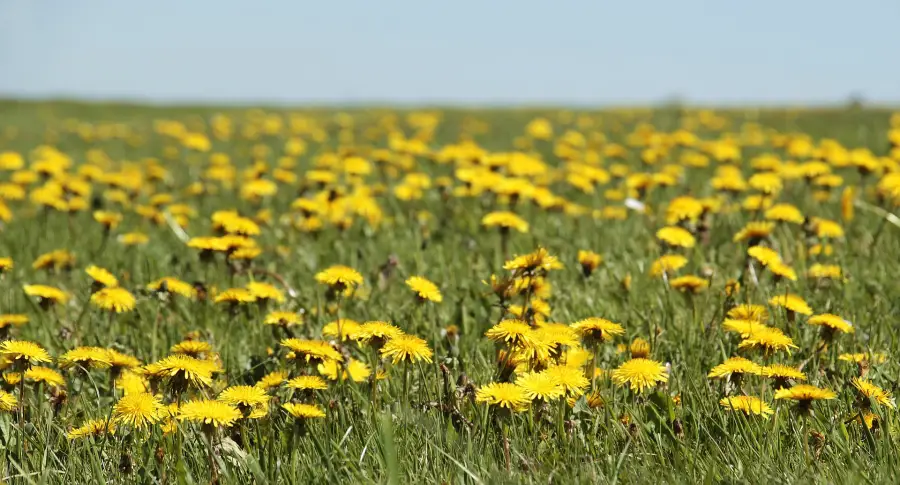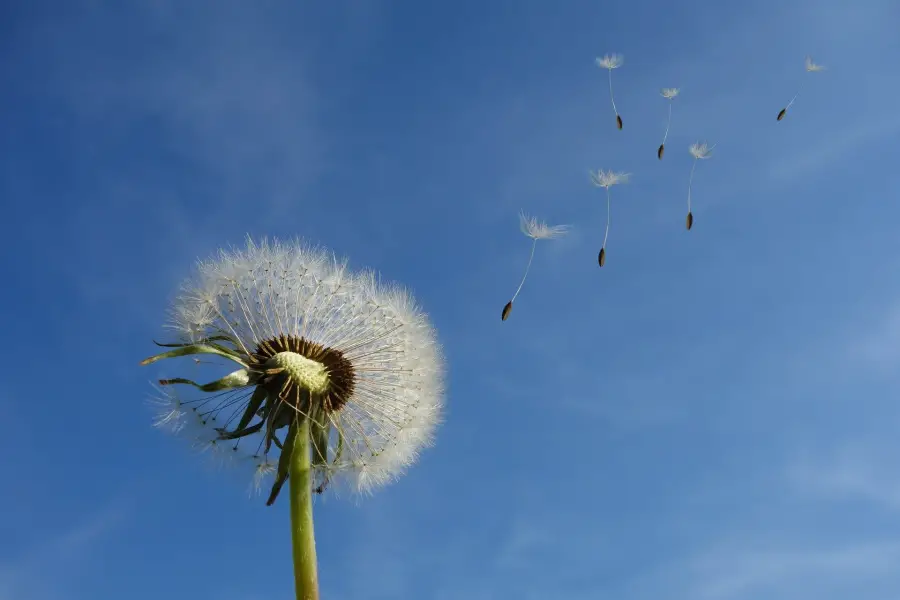Most gardening enthusiasts and landscapers detest dandelions. These yellow-flowered plants can quickly and easily overrun even the best kept garden in a matter of days. Because they spread so easily, dandelions can choke out grass, flowers, and other crops and can be difficult to eradicate.
You can guard against a dandelion infestation by keeping a healthy lawn and mowing often. You can deal with an existing dandelion infestation through uprooting the tap roots, mulching, using herbicides, or spraying vinegar. A combination of both approaches can insure infestations never occur.
Dandelions are broadleaf perennial plants commonly found in distressed or neglected lawns and fields. They are mostly rampant in areas with good drainage and direct sunlight. Read on to find out how to deal with a dandelion infestation.

Contents
Are Dandelions Bad?
Dandelions were first brought to continental America by early European settlers. The settlers used the plant for culinary and medicinal purposes. That’s right, these ‘weeds’ were once and by a small minority still are considered good leafy vegetables for salads and medicines. Some in the southern United States still occasionally eat dandelion salads.
Dandelions can be bad for a lawn since their aggressive growth and propagation rates outpace many others around them. Yet, dandelions are actually not bad for human consumption. They contain healthy and medicinal benefits in their roots, leaves, and flowers.
The leaves can be eaten raw as part of a salad and may also be cooked. The leaves provide an abundance of vitamins A, C, K, and E while also providing minerals such as calcium, iron, magnesium, and potassium.
The roots and leaves also provide antioxidants which help counter the negative impact of free radicals within the human body. The flowers can be used in wine making. Eating dandelion leaves, flowers, and roots can be effective in reducing blood pressure, slowing down aging, and preventing eye diseases such as cataracts.
Dandelions are not only good for human use, they are also beneficial for insect and bird populations and for grazing animals. They provide ecological balance and draw nutrients up from deep in the soil for use by shallow-rooted plants.
Why Do Gardeners Need To Deal With Dandelion Infestations?
While dandelions can be beneficial to some animals and even humans, they can also be a nuisance and an eyesore. Gardeners prefer to keep a green lawn for aesthetic purposes. Dandelions not only ruin the effect of lawn management but can also kill off beneficial plants and grasses.
Dandelions have a prolific ability to regrow even from damaged taproots. They are self-seeding, and their seeds can spread far and wide really fast. They can quickly take over and begin rooting out desirable plants from your lawn and flower beds.
Having some knowledge of dandelions’ growth habits and preferences, gardeners and homeowners can learn effective methods for removal without killing grass and other plants. Some methods for killing off dandelion infestations include:
Method 1: Maintain a Healthy Lawn
Dandelions are opportunistic plants. They will take over a neglected lawn or field and quickly spread. By promoting a healthy lawn with dense growth, dandelions won’t stand a chance to establish themselves. Your lawn plants will suppress dandelion growth and outcompete any dandelion sprouts.
These hearty little plants take advantage of even the smallest thin or bare spots in your lawn. Once they get a foothold, they begin to aggressively expand into other problem areas of your lawn. Making sure that there is thick healthy grass in your green areas is the best prevention for dandelion infestations.
Turf grasses are especially effective at suppressing dandelions. Three ways to keep your turf grass healthy is by aerating, overseeding, and fertilizing. Your grass will grow thicker and denser, denying dandelions the space to grow.
- Overseeding helps to replenish your grass with new plants that will help the overall lawn be thicker and less susceptible to weeds of any kind.
- Aeration creates air pockets in denser soils to allow oxygen, water, and organic material to quickly reach the grass roots. This promotes healthier plants and their propagation.
- Fertilizing if done properly can promote the growth and thickening of your lawn to keep out any flowering interlopers.
There is also a very easy to use product that we regularly apply to our lawns and have for countless customers over the years. Scotts Turf Builder Weed And Feed is specifically designed to simply spread on your lawn as a ‘one stop shop’ for fertilizing and killing broad leafed weeds like dandelions. I swear by it for price, easy of use, and effectiveness.
Method 2: Mow Regularly

Dandelions spread their seeds mainly through wind dispersal. They grow tall, their flowers and seed stalks towering over grass and other garden plants. When there’s a breeze, the white puff-balls carrying seeds disperse to other parts of the garden and to neighboring lawns, gardens, and fields.
Mowing your lawn won’t kill existing dandelions. However, mowing regularly will effectively diminish the dandelions’ ability to spread their seeds and multiply. Mowing cuts down the flower and seed stalks before they can mature and spread.
When mowing, cut your grass at a high blade setting. The tall grass three or four inches high tends to shade dandelion seedlings, denying dandelions sunshine necessary for photosynthesis.
Method 3: Uproot the Tap Root
The most effective method of dealing with a dandelion infestation is to manually pull out the plant by hand. However, take note that dandelions can regrow from damaged tap roots.
For Individual Weeds In Your Lawn
The tap roots can grow up to a foot or more into the ground. To completely kill the dandelion, you have to remove the whole tap root. Using a small gardening tool, loosen the soil around the dandelion. Pull out gently making sure not to leave any break off roots inside the soil.
Also, take note that it’s always easier to pull out tap roots when the soil is moist than when it’s dry. So, work early in the morning when the dew hasn’t evaporated or pull the plants out after the next rainstorm.
Dandelions In Flower Beds
One of the most common scenerios that will have you manually pulling out dandelions is when they appear in your flower beds or gardens. Here is an expert tip that I have used literally thousands of times in you own beds and countless beds of customers.
Use a hand held mattock or sometimes called a garden hoe (like this one I have had for a decade from Amazon). Make two or three good, deep swings at the dirt around the perimeter of the weed. Then gently begin to pull after grasping all of the leaves and plant. This is the way I have gotten countless tap roots out and ensured the dandelions didn’t return.
Method 4: Apply Herbicides
There are two main ways to use herbicides on your lawn. There is the spot method and the broad leaf herbicide method.
Herbicide Spot Method
When you apply herbicides indiscriminately, you risk damaging all your plants, not just the dandelions. instead, target the dandelions by applying directly on them.
This is done by locating each plant on your poperty and applying an herbicide that will kill it (and every other plant it touches) in localized areas. This is a more direct approach, but for infestations that have not taken over more than isolated parts of your yard, it could be the easiest and fastest solution.
Even better, start by pulling out the dandelion then applying the herbicide into the hole left by the root. The herbicide will kill off any remnants of the tap root with minimal risk to other plants.
Broadleaf Herbicide Method
Instead of a non-selective herbicide, you can also use a broadleaf herbicide. The advantage of broadleaf herbicides is they will only kill off broadleaf perennials such as dandelions while leaving other plants such as grass to thrive.
The best time for using any herbicides to control dandelion infestations is before the dandelions have produced flowers. After the flowers have blossomed, the dandelion is likely to build up resistance to most herbicides.
Method 5: Use Vinegar
Chemical sprays such as herbicides can have a long-term negative impact on your soil, garden, and lawn. Additionally, dandelions often grow in hard-to-reach places where you can’t easily reach in to remove the taproot and fill the whole with pre-emergent herbicides. Vinegar offers a much better solution.
The mild amount of acetic acid in vinegar can kill most weeds within a matter of hours. Spray directly on the leaves and stems of the dandelion plant and check in a few hours.
Vinegar is environmentally friendly and has no long-term negative effects on your soil. However, like herbicides, the effectiveness of vinegar isn’t limited to dandelions. Vinegar kills many other plants so apply carefully only onto unwanted plants.
To be sure, some swear by the use of vinegar and some decry its limited effectiveness. Play with the concentrations, time of day, and moisture conditions to judge the results for yourself.
Method 6: Mulching
One of the most natural processes is using mulch or grass clippings to cover up your lawn at least on a semi regular basis. The mulch will shade the dandelion seedlings from receiving sunshine while protecting new seeds from falling onto the soil.
Mulched grass clippings and leaves from trees work to deprive dandelion seedlings of sunlight and oxygen while at the same time disrupting the blooming of dandelion flowers. Nonetheless, mulching is a slow process and often has an unappealing look.
The Final Touches On Controlling A Dandelion Infestation…
The most important consideration when it comes to controlling dandelions is to start early. If you let the spread become extreme, more extreme measures will be needed in order to control it.
There are some that don’t mind the broadleaved invaders in their lawn. But for those that do, hopefully I have given you some solutions to your confrontation with this very hearty little plant.
To see more articles like this one…
